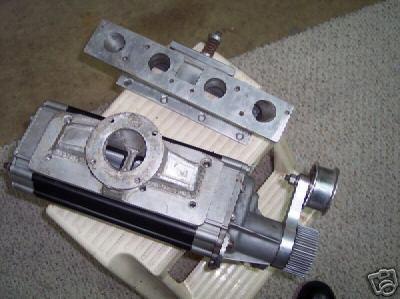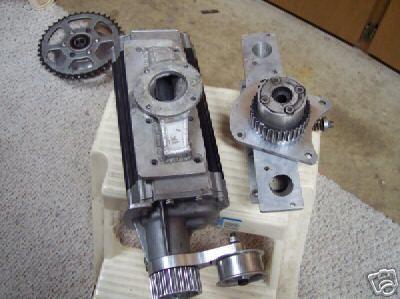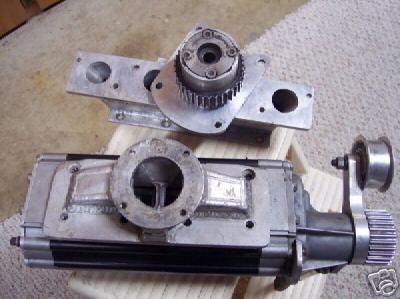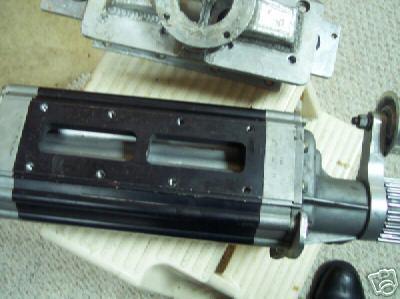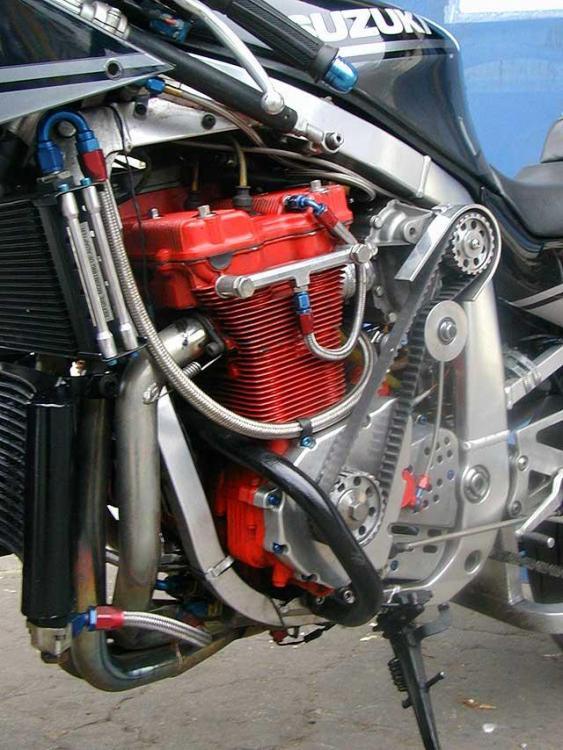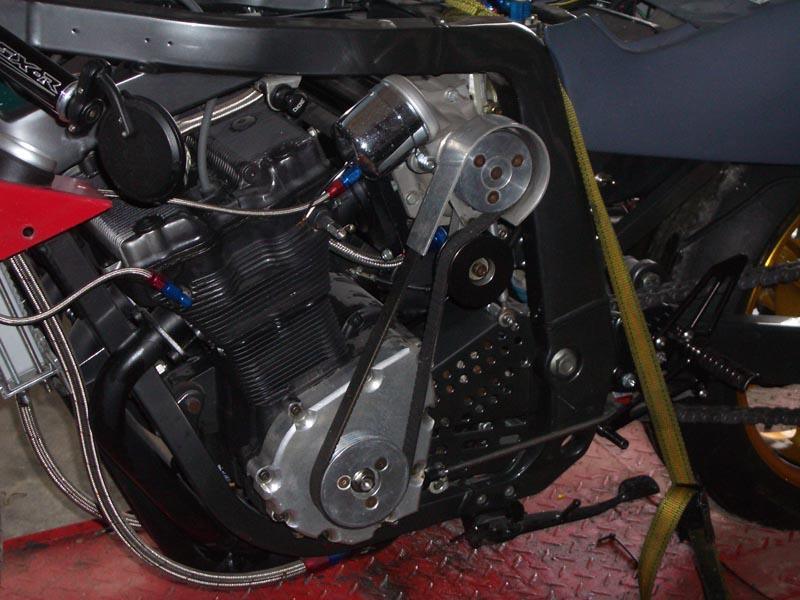-
Posts
5,758 -
Joined
-
Last visited
Content Type
Profiles
Forums
Events
Everything posted by Gixer1460
-
Query - absolutely stock head or have the valve guides been replaced? If the latter, they maybe to high and are getting clouted by the spring retainer - likewise if using a Higher lift cam - same effect. Not much else unless the guides are badly worn so valve stem is knocking them out? Lots of oil / assembly lube whilst fitting them - difficult to damage really unless seating them with a mallet!
-
Psssst - the most powerful GSXR based proper streetbike in Europe has top end link bars...................just sayin' like!
-
A footrest cracking is an inconvenience - a broken front brake lever is a tad more serious! I've snapped and bent OEM levers ONLY by throwing the bike down the road - any other time and IMO, makes them not 'fit for purpose'
-
Interesting combination abit overly complicated IMO? Question why not add banjos or 90 deg. elbows, direct to the aeroquip and avoid all the multiple fittings? How does it all fit with the exhaust - all looks a bit tight ie. can filter be removed with headers in place?
-
Further to Clive's post above I found some other pic's of that kit that I thought were DIY - don't have the feel of a product - rather something built in a shed? They may be of some use.
-
The alternator looks at the voltage that is applied to it from the ign. sw. to determine its output. The wiring from the battery to the ign. sw. and back to the alternator induces a voltage drop down to, say, 12.2 volts so the alternator ramps up its output potentially overcharging the battery. So with the relay, you are connecting the battery direct to the alternator with less voltage drop so less chance of over-charging.
-
-
Good luck - i've only ever seen pictures, never in the metal. They are rare in the USA so this side of the pond is anyone's guess?
-
I think thats gonna need some persuasion with the heavy engineering adjustment mallet! Is it welded yet or just pressed - could have pulled with the welding (if it was!)
-
Robinsons Foundry - mention OSS membership and get a small but appreciated 10% discount.
-
As i'm no physics major i'll ask the Q - does the magnet strength have any bearing on the eventual output? I see that a lot of the hybrid / electric vehicles use high efficiency motors having neodymium magnets in place of the old ferrite magnets. All of these rotors are a) over 35+ yrs old, b) heavy c) magnetically 'tired' - so I was thinking, break out the old ferrite and add back lots of new neodymium bar magnets and re-glue...........would it work?
-
'same for all OSS engines' is a broad sweeping statement and NOT factually correct! The Hippo engine was based on the 1127 cc engined GSXR family series - nothing else! If the crank is unknown then you can use the references stamped on the cases to give one half of the bearing sizing information but the crank journals need to be measured accurately to determine the ID bearing size required. Then you'll have to use a sizing chart to determine the correct sizing - there are 3 sizes available for the mains and 3 sizes for the rod big ends - so lots of combinations. Unlike with cars, lorries etc. bearings are generally only available OEM - no aftermarket suppliers, no shortcuts!
-
I'm struggling to see a 'first generation' frame there! More akin to a pre-prototype frame, factory built to go racing with a GS motor full of magnesium, one off, ltwt. castings - as a GS thou motor just will not fit into a std production Gen 1 GSXR frame as we all know! The XR41 frame looks more like a Harris with square tube...............could even be steel for all I know LOL!
-
A rising rate FPR works like a Rising rate suspension linkage which increases stiffness the more it moves. The RR FPR's increase pressure in an increasing ratio more than the boost being applied ie 1lb boost will get, say, 1.1psi fuel pressure, 2lb boost will get, say, 2.2psi fuel pressure etc. These figures are applied on top of the baseline fuel pressure but the mapped injector opening times remain exactly as when mapped NA. The downside is boosted engines require fueling that isn't necessarily linear so could be lean or rich with no way of tailoring it exactly. Also the pump has to supply sufficient flow for NA flow, then added boost pressure + the additional increase BUT generally all pumps decrease flow the more pressure they are required to provide, so a pump that gives, say, 200ltrs @ 3 bar for NA but at 10lbs boost might only flow, say, 150ltrs however if a RRR is used the now extra 11lbs pressure could result in 140ltrs ! ! just when you need the most flow! Proper mapping keeps a constant FP across the injector (boost pressure increases FP but air pressure is the same so its equal) and increases the injector opening period to match actual demand -- this is the correct way. The RRR way is generally used by people who want to use a non mappable ECU and with ratios of up to 1.7 : 1, the pressure increases on the pump get daft ie. 20lb boost will require FP of 43 + 20 + 14psi = 77psi which will nearly stall most pumps! Hope that helps ?
-
Yes - but they do go extremely well with a younger generation engine in the hole!
-
If those are figures for an H4 LED headlamp I think they are a bit pessimistic (unless that is a measured figure) as the one i've got in my daily is about 9w dip and 18w main - each side is 3No. Cree type LEDs, both sides turn on for High beam! Don't forget the Horn ! Saw a bike that died everytime you beeped the horn - voltage / current was so marginal that the horn tipped it over the edge LOL!
-
Thinking about std. Katana wiring - changing all the bulbs to LED won't make a bit of difference, even turning them off as that age of alternator had one phase feeding the lights directly. If you re-wire the RR output all to battery it may help? They are still pretty piss poor at best of times ...... 180 - 200w output I seem to remember?
-
Steels are bullet proof unless warped and if they were it would be dragging like a bastard! So down to £160 and OSS discount = £16 so £144 + postage ! EBC don't come with steels so at least compare apples with apples! Know which one I'd go with - and have!
-
Slabby = Slabside = early GSXR upto 85/86 .......... Slingy = Slingshot = Later GSXR after 85/86.
-
Hmmm - decent 16" rubber is/was getting a bit scarce, or it was when everyone was using them in Superstreet bike - so a switch to 17" would be logical choice?
-
Unless doing a lot of cold starts or the engine is a bad starter that needs a lot of cranking before firing then a higher AH makes no real difference. Better to look for the highest CCA rating for whatever battery you choose (Cold Cranking Amps). If you are increasing elec. loads via fuel injection, extra lights etc then the piss poor alternator is the first upgrade to be considered!
-
Firstly were original 83 750's still on 19" or 17's? If the former you're on a hiding to nothing! If its the fork - disc - caliper situation, then it makes considerably more sense to do a whole front end swap rather than a bit here and a bit there and then a multitude of spacers and washers to make it all work together!
-
Never heard of anyone trying but seeing the 4" gap front to back when doing the reverse, its deffo gonna need stretching - then the GSX motor is also taller than even the 1100 oiler, that dimension is going to be a squeeze as well i'd imagine.......can't actually see the appeal as it weighs lots more!
-
Hmmmm - EBC plates - some like them, but having replaced numerous sets on various bikes, I can't support them. OEM plates aren't significantly more expensive - bit like brake pads - OEM is often cheaper - who'd have thunk that!
-
I do occasionally suffer a similar effect on my daily - not a 'zuki so won't mention it - and its shaft drive so deffo no chain to skip! I believe its clutch related also - changed the plates a while ago and hasn't done it so much recently. These clutches seem to be a bit particular with friction material and oil used. I tend to stick with OEM for plates and a mineral or semi synth changed every 6 months. Ridges in the basket teeth won't help either but seem less of a problem than they should be!




